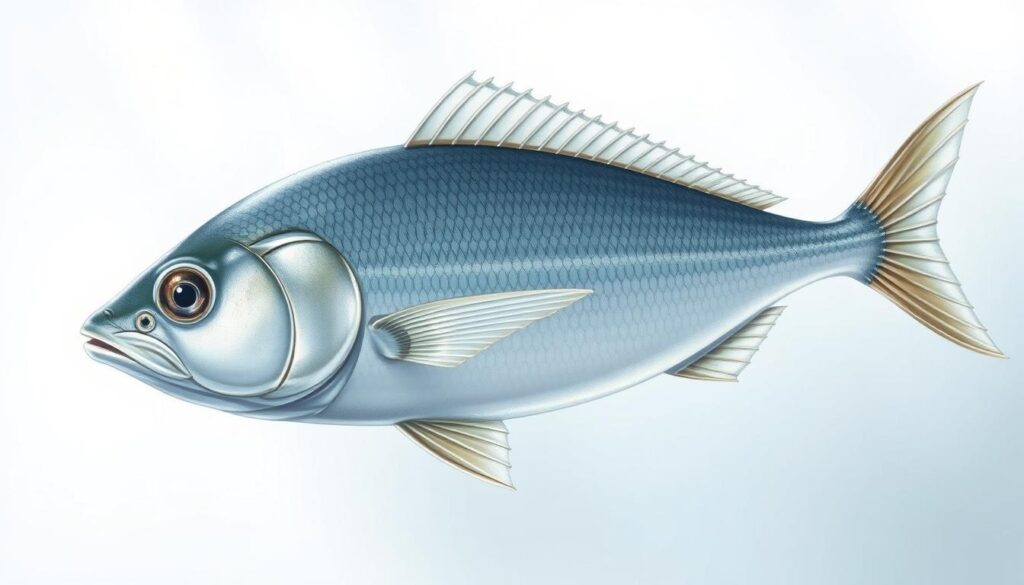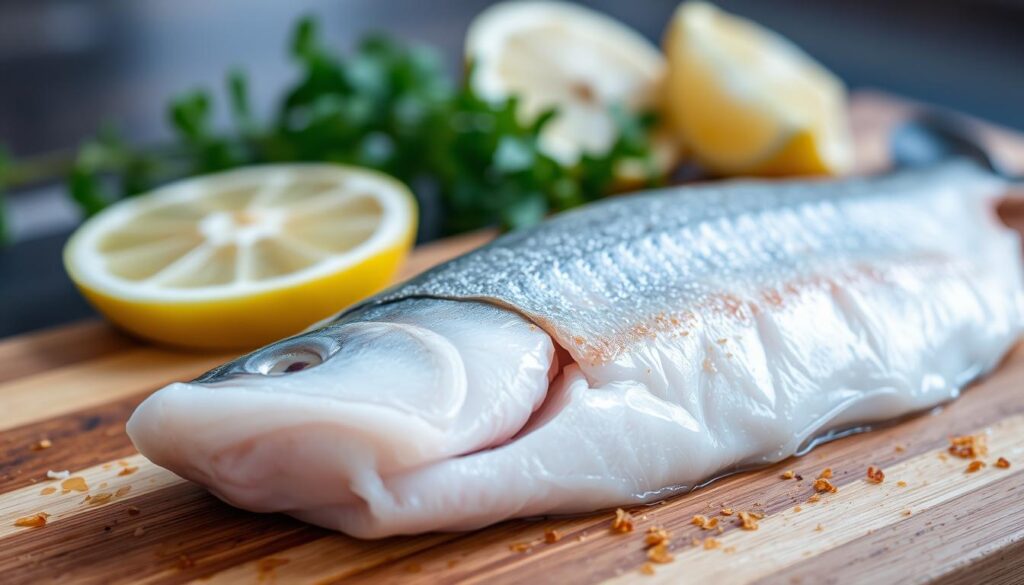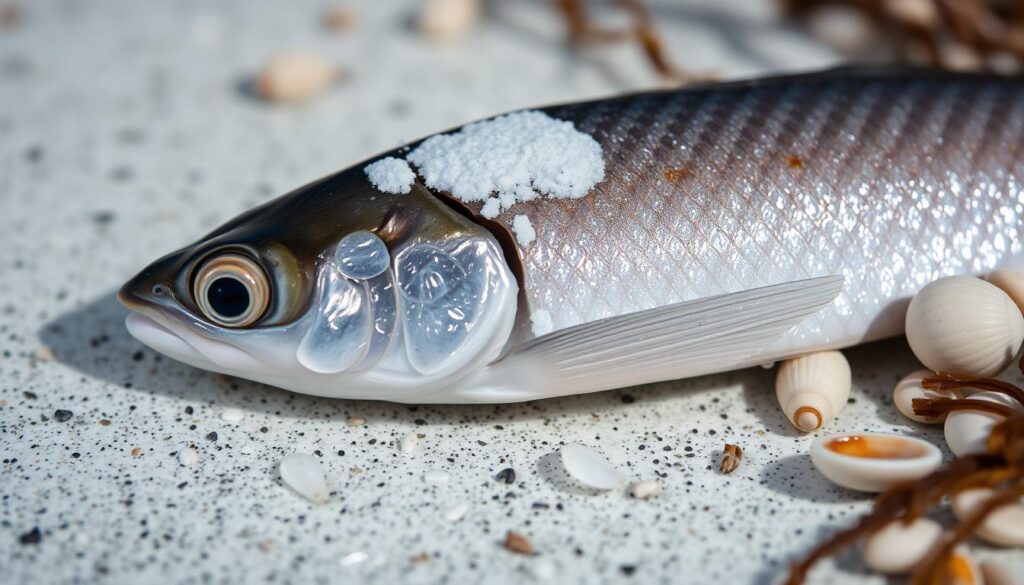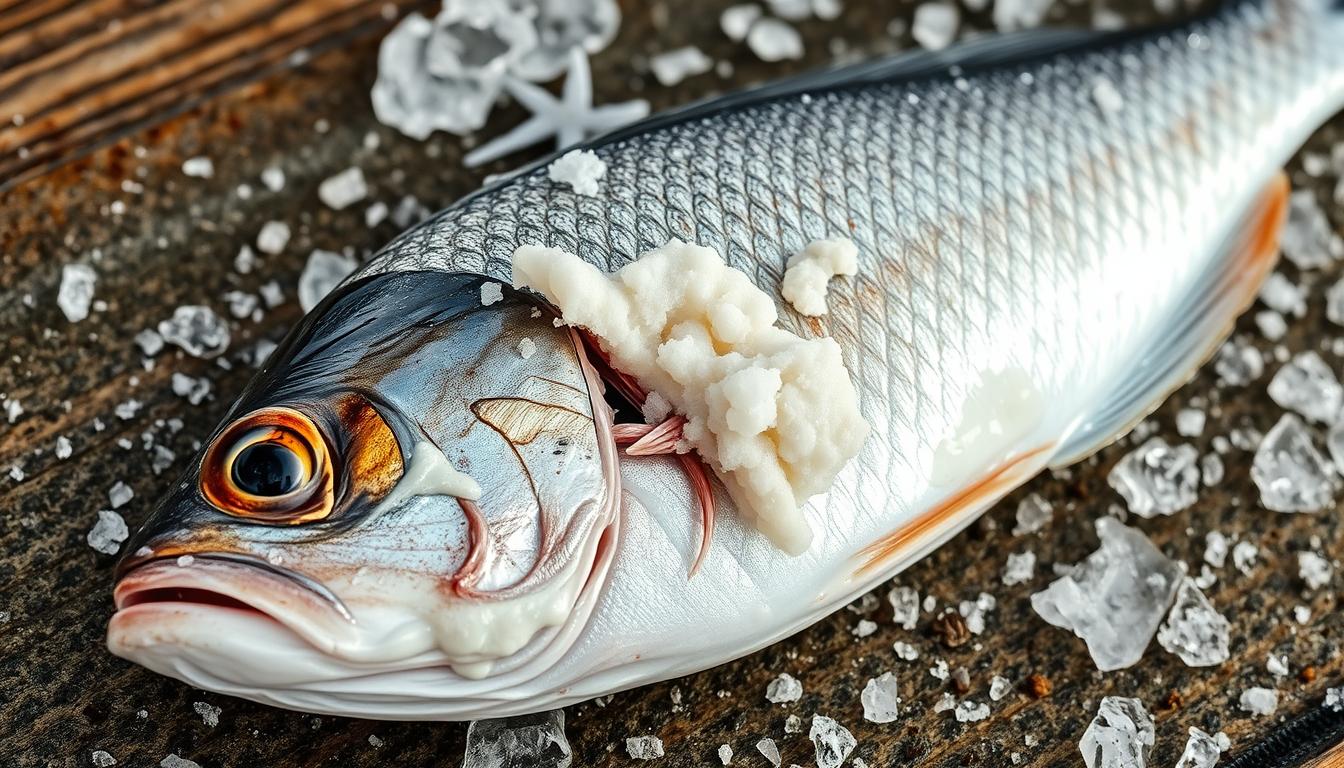Ever pulled a fresh whiting fish from the fridge and saw a white coating? It can surprise even the most experienced cooks. Learning about your fish can turn uncertainty into confidence in the kitchen.
The white stuff on whiting fish isn’t always bad. It might be due to the fish’s protein or could mean you need to check it closer. Knowing about this white residue can boost your seafood cooking skills.
If you cook at home or love seafood, knowing about this white substance is key. It helps you decide if your fish is good to eat. Let’s explore the world of whiting fish and solve this kitchen mystery.
Key Takeaways
- White substances on fish can have multiple origins
- Not all white residues indicate spoilage
- Understanding fish protein behavior is crucial
- Visual inspection is an important first step
- Proper storage prevents unwanted fish changes
Understanding Whiting Fish

Whiting fish is a tasty and healthy seafood choice. It comes from the cod family and lives in oceans worldwide. This fish is a lean protein that can be cooked in many ways.
Keeping whiting fish safe involves proper handling and cooking. Each type of whiting has its own special traits that seafood fans love.
Distinctive Physical Characteristics
Whiting fish usually has:
- Slender, elongated body shape
- Silver-white coloration
- Small mouth with sharp teeth
- Average length between 8-12 inches
Common Whiting Species
Many people know these whiting species:
- Merlangius merlangus (European whiting)
- Pacific whiting
- Silver hake
- King George whiting
“Whiting is an excellent choice for those seeking a mild-flavored, low-calorie fish option.” – Seafood Nutrition Foundation
Learning about the white substance on whiting can enhance your enjoyment of it. Each species adds something special to your meal, making whiting a great fish to try.
Identifying the White Substance

Seeing a white coating on whiting fillet can worry you. Knowing what this white film is can tell you if it’s okay or not.
Visual Characteristics of the White Substance
The white stuff on whiting fish looks different. Here’s what to look for:
- Color: It’s usually pale white or off-white.
- Texture: It can be thin and filmy or thicker and more opaque.
- Location: It’s often on the fish fillet’s surface.
Distinguishing Normal from Abnormal
Not every white coating is a problem. Some are normal, while others might mean trouble:
- Normal white coating: It’s from protein coagulation when it’s refrigerated.
- Potential concern: A thick, fuzzy, or discolored white film.
“Fresh fish should have a clean, mild appearance with minimal white substance.” – Seafood Quality Experts
When you check whiting fish, watch the white film’s look. A thin, clear layer is usually okay. But a thick, milky, or textured white coating might mean it’s spoiled or has bacteria.
Causes of the White Stuff

When you see a white substance on whiting fish, it could be due to several reasons. Knowing these can help you tell if it’s normal or if it’s a food safety issue.
Protein Coagulation During Cooking
The white stuff on whiting fish usually comes from protein coagulation. When fish proteins heat up, they change and form a white, milky substance. This is a natural process that happens when you cook the fish.
- Occurs at temperatures around 140-150°F
- Represents proteins realigning during heat exposure
- Typically appears as a thin, white layer
Parasites in Whiting Fish
Parasites can also cause white substances on fish. Even though most parasites are tiny, they can leave white spots or residues. These signs might mean the fish is contaminated.
| Parasite Type | Appearance | Risk Level |
|---|---|---|
| Roundworms | Small white threads | Moderate |
| Tapeworm larvae | White cysts | High |
Spoilage Indicators
Not all white stuff is safe to eat. Some white residues can be signs of spoilage. Fresh whiting fish should look clean and clear without any unusual buildup.
“When in doubt, throw it out” – Food Safety Experts
- Milky film with strong odor = potential spoilage
- Thick, opaque white coating = bacterial growth
- Discolored white patches = possible contamination
Health Implications
It’s important to know if whiting fish is safe to eat. The white stuff on it might make you wonder if it’s okay to eat. Let’s look into the safety of whiting fish and how to tell if it’s good to eat.
Is It Safe to Consume?
Most of the white stuff on whiting fish is safe. It happens when proteins coagulate during cooking or storage. Not all white residue indicates spoilage. To make sure the fish is safe, look for these signs:
- Check for a fresh, mild ocean smell
- Examine the fish’s texture and appearance
- Verify the storage conditions
Identifying Contamination Signs
Spotting contamination is crucial to avoid getting sick. Look out for these signs that the fish might not be safe:
- Strong, unpleasant fishy odor
- Slimy or discolored surface
- Visible mold or unusual growths
- Soft or mushy texture
“When in doubt, throw it out” – A golden rule for seafood safety
Keeping the fish safe is all about handling and storage. Refrigerate it quickly, cook it well, and eat it within the right time. This helps avoid health risks from the white stuff or contamination.
Preparation Techniques
Preparing whiting fish needs careful steps. The right way to prepare it makes it tasty and reduces unwanted white stuff that might show up when it’s cooked.
Essential Cleaning Methods
Cleaning the whiting fish well is key for great taste. Here’s how to do it right:
- Rinse the fish under cold water
- Use a fish scaler or a knife to remove scales
- Empty the inside, taking out all organs
- Pat it dry with paper towels for better seasoning
Cooking Techniques to Minimize White Substance
There are ways to cook that can lessen white protein:
| Cooking Method | White Substance Reduction | Recommended Temperature |
|---|---|---|
| Baking | Moderate reduction | 375°F |
| Grilling | Significant reduction | 400°F |
| Pan-frying | Minimal reduction | Medium-high heat |
“The key to perfect whiting fish is gentle handling and precise temperature control.” – Seafood Chef Michael Roberts
Marinating the fish before cooking can also help. Use lemon juice or vinegar to soften the surface and make it smoother.
Pro Tips for Perfect Preparation
- Always use fresh whiting fish
- Clean fish right before cooking
- Avoid overcooking to prevent white substance buildup
- Use a meat thermometer for exact cooking
Getting good at preparing whiting fish takes time, but these tips will help you make amazing seafood dishes at home.
Storage and Handling Tips
Proper handling of whiting fish is key to keeping it fresh and safe. If not stored right, fresh whiting can spoil quickly. This can cause a white coating on the fillet, a sign of spoilage.
Knowing the best storage methods can help your fish last longer. It also prevents quality issues. Here are some tips to keep your whiting fish fresh:
Refrigeration Best Practices
- Store whiting fish at temperatures between 32-38°F
- Use airtight containers or sealed plastic bags
- Place fish on a bed of ice in the coldest part of your refrigerator
- Consume fresh whiting within 1-2 days of purchase
Freezing Techniques
Freezing is great for longer storage of whiting fish. Follow these steps:
- Wrap fish tightly in freezer-safe plastic wrap
- Use vacuum-sealed bags for best preservation
- Label packages with the date of freezing
- Store frozen whiting for up to 3 months
Preventing White Coating
Proper handling can minimize the white substance that sometimes appears on whiting fillets. Keep fish dry and cold. This reduces protein coagulation and bacterial growth.
“Fresh fish is about careful handling from ocean to plate” – Seafood Preservation Expert
Storage Comparison
| Storage Method | Maximum Storage Time | Quality Preservation |
|---|---|---|
| Refrigeration | 1-2 days | Good |
| Freezing | 3 months | Excellent |
| Room Temperature | 2 hours | Poor |
By following these handling tips, your seafood will stay fresh, safe, and tasty.
Conclusion
Exploring whiting fish can be challenging, especially with the white film issue. You now know how to spot, handle, and cook whiting fish safely.
Summarizing Key Insights
The white film on whiting comes from proteins, parasites, or spoilage. Knowing this helps you choose better fish and cook it right. Storing, cleaning, and cooking fish correctly keeps it fresh and safe.
Final Thoughts on Whiting Fish
Knowing about the white film on whiting is crucial for seafood lovers. It lets you pick, prepare, and enjoy whiting fish with confidence. Fresh, well-handled fish makes for a great meal.
This guide has prepared you to handle whiting fish with confidence. Now, you can turn concerns into delicious meals.

